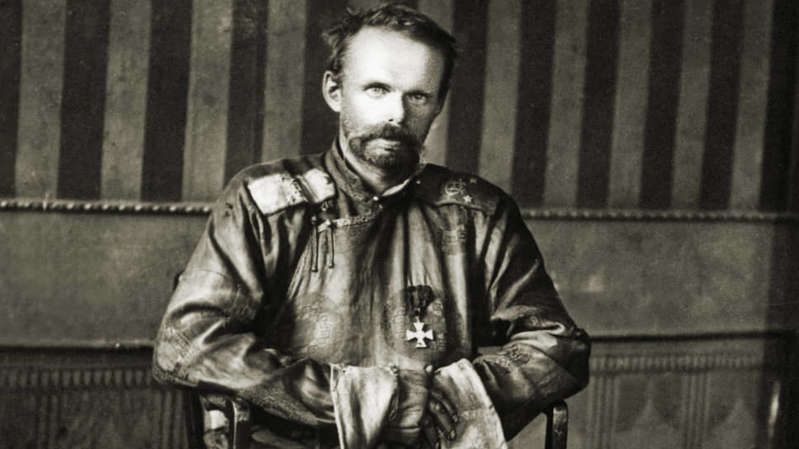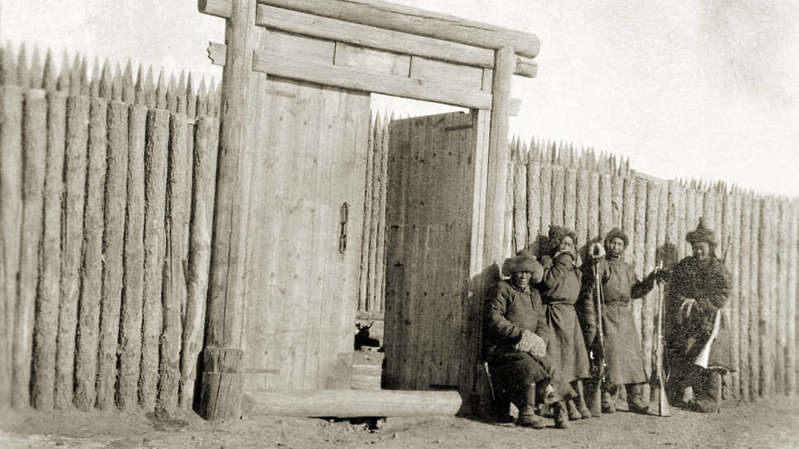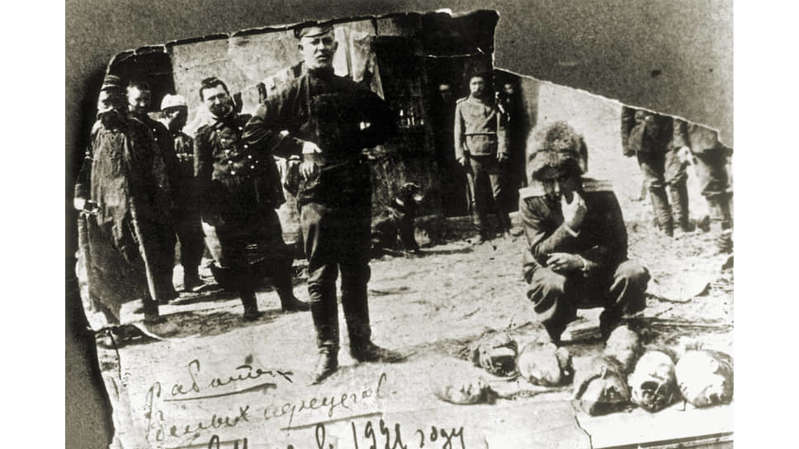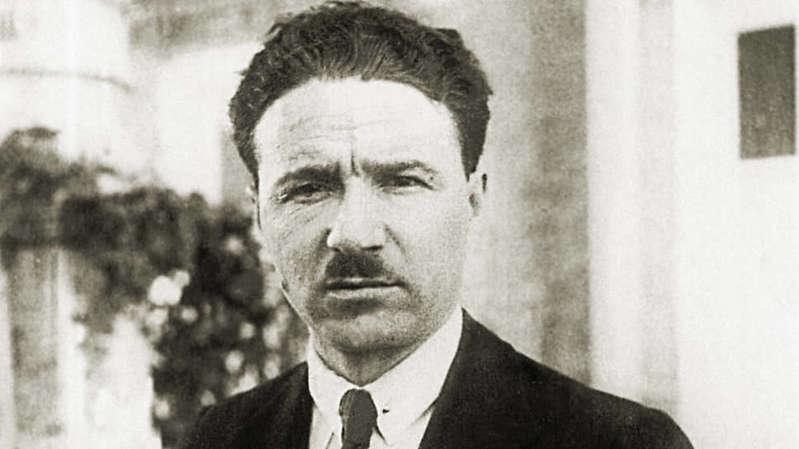
“There is no doubt about success, as it is based on a strictly deliberate and broad political plan.”
With what cunning the famous baron was defeated
A hundred years ago, in August 1921, after the entry of Soviet units into Mongolia, one of the most consistent enemies of the Bolsheviks, the head of the Asian Cavalry Division, Baron R.F. von Ungern-Sternberg, was captured. Three months earlier, he ordered the units subordinate to him to begin a liberation campaign in Siberia, not suspecting that he was acting in strict accordance with the disastrous plan for him, approved in Moscow.
“I was actively involved in the work of the headquarters”
It was not only very difficult, but practically impossible to believe that two military-political problems of exceptional complexity could be solved with the help of one simple plan. Especially considering that to call the situation in Siberia and the Far East extremely difficult was to say nothing.
By the end of 1920, anti-Bolshevik armed detachments and units were driven abroad, but continued to be an impressive force. Only under the command of Baron RF von Ungern-Sternberg, who left for Mongolia, according to data obtained in Moscow from various sources, there were from 5 thousand to 7 thousand experienced and well-armed cavalrymen. It was noted that in the units of Ungern there are many machine guns and artillery pieces.

“Try to fight Ungern on Mongolian territory by the forces of the Mongols themselves”
It would seem that the divisions of the Red Army could cross the border and defeat the troops of the baron. However, such a head-on solution of the problem was hampered by many circumstances. The Soviet troops stationed in Siberia were divided into two parts. One of them was subordinate to the Revolutionary Military Council of the Republic (RVSR) and the General Staff of the Red Army. And the other, albeit purely formally, was part of the armed forces of the buffer state created in April 1920 – the Far Eastern Republic (FER), which had all the signs of a democratic state, but in fact controlled by Moscow.

“The Mongols first welcomed the arrival of Ungern, now they are beginning to become disillusioned with the violence and arbitrariness committed by whites” (pictured)
But despite the obvious sham character of the FER, any use of its troops in the interests of the Bolsheviks could cause a quick and quite predictable reaction from Japan and Great Britain, who considered the Far East a zone of their special interests. And right up to a full-scale invasion.
Therefore, for some time the question of a purely secret involvement of units from the FER army in an operation against Ungern's troops was considered.
But the combined forces for the most part consisted of infantry and could not successfully fight in the endless steppes with cavalry. And quickly transferring reinforcements from the European part of Russia after the end of the Civil War there turned out to be extremely difficult – devastation reigned on the railways and a food crisis was growing. It was necessary to take into account the fatigue of the Red Army soldiers accumulated during the war years. Especially older people.
There was another significant problem. Over the years, the Russian Empire made a lot of efforts to make Outer Mongolia, which belongs to China, a part of its possessions and, acting carefully so as not to provoke the outrage of the great powers, achieved serious success in this. In 1912, taking advantage of the chaos that followed the revolution in China, the Russian government recognized Mongolia's autonomy and confirmed that “Mongolia's former relations with China have thus ended.”
But after the two Russian revolutions in 1917, the situation changed. And despite all the internal strife, the two opposing Chinese governments and the generals who were not subordinate to anyone, who controlled the Chinese provinces with the troops loyal to them, were unanimous that Outer Mongolia, as an integral part of China, must be returned. And Chinese merchants from different parts of the country eagerly responded to the call to contribute money to pay for a military operation to return the treacherously seized territory. So in 1919, the Chinese units were able to regain control over most of Mongolia and its capital, Urga. And at the slightest violation of the border by Soviet troops, the Chinese representatives, regardless of their political orientation, threatened to retaliate.

“Our plan for the Mongol operation,” wrote BZ Shumyatsky to G.V. Chicherin (pictured), “began to be realized.”
True, this provision did not in the least prevent the comrades from the Central Committee of the RCP (b) and the Communist International (Comintern) to prepare the ground for socialist transformations in Mongolia. Thus, the Mongolian People's Revolutionary Party was created, to which the Soviet representatives guaranteed significant assistance in money and weapons to increase the ranks and strengthen the fighting efficiency. But due to the depressing economic situation of the RSFSR, the revolutionary Mongols were only repeatedly confirmed that their promises would soon be fulfilled.
When analyzing the chances of success for events in Mongolia, one should also take into account the position of the nobility and clergy, who had a huge influence on ordinary Mongols. But this elite, as representatives of the Central Committee and the Comintern reported to Moscow, were guided exclusively by their own interests, and depending on the situation, the groupings in it were ready to orient themselves, some on the Chinese, some on the Bolsheviks, some on Ungern.
To complete the picture, a few more touches should be added to it. The transmission of secret messages from Siberia to Moscow and back left much to be desired. Due to errors in encryption and transmission, messages had huge gaps that distorted their meaning. In some cases, cipher telegrams were waiting for processing for several days and urgent requests remained unanswered. It happened that messages to the center began with the words:
“We repeat our telegram, which you have not compiled, in corrected form.”
In addition, the Soviet comrades who were in Siberia and responsible for the affairs of Mongolia often sent unverified information to Moscow and were not always inclined to follow the instructions from the center exactly. So, in 1920, despite numerous and categorical prohibitions to cross the border, units of the Red Army, pursuing separate groups of whites, crossed it. O.I. At the same time, in his other telegram about the same raid it was said:
“The complete inviolability of Mongolia and property was respected. The behavior was so correct that the Mongols were surprised by the decency of the Reds. “
The Plenipotentiary of the People's Commissariat for Foreign Affairs believed that it was he who should direct the policy towards Mongolia on the spot. But the leaders of the Far Eastern Secretariat of the Comintern, F. I. Gapon and B. Z. Shumyatsky, categorically objected to this.
“He,” Shumyatsky telegraphed to Moscow about Maksteneck, “thanks to his narrow-mindedness, petty vanity, despite my order of non-interference and strict secrecy, he was still actively confused in the work of the Mongolian headquarters, pretending to be the role of an official leader.”
And the authorized NKID wrote to the capital about his past revolutionary achievements and complained about the oppression by Shumyatsky. Disagreements among leaders in Moscow added fuel to the fire. The deputy head of the People's Commissariat for Foreign Affairs LM Karakhan, for example, supported Maksteneck and the military, who were striving to launch an operation against Ungern's troops no matter what. And the People's Commissar for Foreign Affairs GV Chicherin was closer to the position of Shumyatsky, who insisted on the need not to rush and soberly evaluate all the pros and cons.
“Smash and destroy”
The main obstacle to the defeat of Ungern's troops and the Sovietization of Mongolia unexpectedly self-destructed. On November 4, 1920, the commander-in-chief of the armed forces of the republic S.S.Kamenev telegraphed to his assistant in Siberia V.I.Shorin:
“The White Guard troops of Baron Ungern occupied Urga and the Chinese troops were unable to prevent this invasion, which is why the Chinese border authorities asked us for help to jointly eliminate the Whites. In agreement with the People's Commissariat for Foreign Affairs, I order you to render full assistance to China and, entering Mongolia, defeat and destroy the troops of Baron Ungern. Your suggestions about this operation and what forces it is planned to carry out, as well as the timing of the start to convey. “
However, the Chinese authorities very soon withdrew their request, announcing that they themselves had defeated Ungern. But in reality, the situation looked different. On November 24, 1920, Gapon reported to Moscow:
“The main part of Ungern's forces, which had the task of capturing Urga, after a serious battle with Chinese troops, leaving about 300-600 killed, withdrew about 40-50 versts east of Urga. Separate small detachments of the Ungernites are scattered in different directions for the purpose of military intelligence, diverting Chinese forces, and detecting forage. “
At the same time, significant assistance in the implementation of Ungern's plans, as Gapon wrote, was provided by the Chinese authorities and the military, who themselves were revolting the Mongols against themselves:
“The Chinese authorities in Urga, in connection with the general severity of the situation … are making arrests, flogging, torture.”
Moreover, as follows from the same report, Ungern's chances of success were very significant:
“According to information, however unverified, an insignificant part of the Semyonov, Kappel detachments, driven out of Transbaikalia, are sent deep into Mongolia to reinforce Ungern's forces. These Semenov and Kappel detachments total from 4 to 6 thousand people. Connected with Ungern, they represent the fist of about 10,000 people. After these detachments are united, the possibility of a secondary attack on Urga and the capture of the latter is likely, if by that moment the Chinese troops have not received solid reinforcements. “
At the same time, Gapon reported that, according to the information received, Ungern was not an independent figure, but a screen that the Japanese were using to implement their own plans.
On December 31, 1920, information was sent to Moscow that the Chinese were not receiving any reinforcements. And more and more forces are being drawn to Ungern. True, as it turned out, the total number of his troops was no more than 5 thousand soldiers. But the number of Ungernians was no longer considered a decisive factor.
A little later it was possible to establish (and then this was confirmed by the captured documents of the baron) that there were Japanese instructors in his detachments. In the Chinese provinces bordering the RSFSR and the FER, with the help of the Japanese and with Japanese money, recruitment points were opened, at which white officers and soldiers were offered substantial rewards for joining Ungern's troops. And the baron himself was supplied with money so generously that he turned into a kind of financier, and therefore a mentor for the commanders of other anti-Bolshevik detachments.
So, in response to the request of the ataman of the Amur Cossack army, General I. Ya.Shemelin, about the money, the baron wrote:
“Dear Ilya,
You are not the Ataman of the Amur army, but a fool … Are you in your mind, asking to send 5000. I am sending you 1000 dollars, and I don’t care about your expenses for an apartment, you can even rent entire palaces, but I won’t give you money for that. If you stay out of work, come and feed ”.
“At the behest of Ungern”
To clarify the plans of the Japanese, as it was reported to Moscow, all the forces of the military intelligence agents were thrown. And Gapon reported on the results obtained on January 23, 1921:
“Undoubtedly, Japan will be able to come to terms with Beijing, relying on the current situation, which China is not able to overcome on its own, in the sense of restoring Mongolia's autonomy and transferring to Japan the rights of the former imperial Russia, which Japan sought under Kolchak.”
The same report also mentioned the ultimate goal of the Japanese:
“The actions of Japan, carried out recently in the Primorsky region, clearly show that we are on the eve of an energetic and consistent formation by Japan of another, more dangerous and loyal buffer against us.”
The situation was extremely unpleasant. A huge strip of Japanese-controlled territory along the Soviet borders gave it the opportunity to launch an offensive at any point and in any direction. The Soviet representatives were especially worried about the presence of the Japanese in Mongolia, from where, as stated in the documents, it was possible with one powerful blow to cut off all the routes of communication between the Far East and Eastern Siberia with the European part of Russia. Even the very threat of such actions could force the Soviet government to reckon with the most unpleasant demands of the Japanese authorities.
Preparations for the complete capture of Mongolia by Ungern were supported by an intensified propaganda campaign in Japanese and Chinese publications, which were called low-quality in Soviet documents. They published stories about the superman baron, endowed with powerful force, he cannot be killed, and his appearance on the battlefield leads to the flight of the enemy.
The same fables were disseminated by Japanese agents among the inhabitants of Mongolia.
The Japanese, it was alleged, also belonged to the idea attributed to Ungern to recreate the empire of Genghis Khan, which delighted many Mongols. Against this background, Japanese mediators helped the baron to negotiate with the Mongol princes, who sent their people to his troops.
On February 2, 1921, F.I.Gapon reported to Moscow about the nationalist-minded Mongols:
“Their contact with Ungern, and therefore with Japan, is almost a fait accompli, concretely expressed in the form of armed and other assistance to Ungern.”
In the same message, the attention of the country's leadership was drawn to the fact that as the baron became stronger, anti-Bolshevik elements on Soviet territory also intensified. Gapon proposed to arm the detachments of the Mongolian People's Revolutionary Party as quickly and fully as possible to fight Ungern, send instructors and supplies to them.
But even the most urgent execution of this request could not stop the capture of Urga by Ungern's troops. On February 4, 1921, the baron began an assault and took the city. His Asian Cavalry Division was greeted in the city as liberators. As a hero, Ungern was greeted by the hutukhta Bogdo-gegen VIII, who was freed by him, the head of Buddhists and the ruler of Mongolia, who was held under arrest by the Chinese authorities.
But the baron could not play the role of a noble liberator for a long time. His associates were actively enriching themselves at the expense of the local population, and on March 12, 1921, Ungern issued an order regulating this process.
“I prohibit the production of arbitrarily without the permission of the Commandant of the city of arrests (except for Jews), searches and requisitions.
I order the Jews who have notes from me not to detain them. “
At the same time, the widespread withdrawal of edibles was not only not prohibited, but also encouraged:
“More stupid than the people sitting in the division headquarters,” said the same order, “no, I order no one except the messengers to give out food for three days.”
Disappointment befell not only the inhabitants of Urga, but also the princes who supported Ungern. On March 17, 1921, B.Z.Shumyatsky reported to Moscow about the events that accompanied the announcement of Bogd-gegen VIII by the Mongol monarch:
“On February 23, Khutukhta was enthroned in Urga, and a government was formed on Ungern's orders. Ungern expelled the candidates proposed by the princes and approved by Hutukhtou, replacing them with his own, and in addition to persons of a definitely White Guard and Japanese orientation, he was obviously put in the government, obviously not even deliberately, but by accident, influential persons affiliated with the People's Revolutionary Party. “
But this government, as reported by Shumyatsky, did not decide anything:
“The arrivals report that the government has no power in Urga, all affairs are ruled by the newly established sixth Yamyn – the creature of Ungern.”
Shumyatsky also reported encouraging news:
“The arrivals testify that the Mongols initially welcomed the arrival of Ungern, now they are beginning to become disillusioned with the violence and arbitrariness perpetrated by the whites, I personally believe that mainly due to the economic hardships that fell on them in connection with the need to forage, supply food and provide combat vehicles. armies, moreover, armies of newcomers. “
In the meantime, the baron continued to revel in power, and, apparently, he began to feel the usual dizziness of success in such cases. He either wrote messages to the Soviet government on behalf of the Mongolian with a proposal for peace and friendship, then prepared proclamations for the people of Russia demanding to immediately take part in the overthrow of the Bolshevik power, then called upon all branches of the Mongolian people to gather together and continue the path of conquests of their great ancestors.
At the same time, Ungern did not forget about his own pocket. And in a letter to one of his comrades-in-arms, he offered to tell where the rich Jewish merchants hid their livestock, promising a percentage of the sale of what was found for the information.
“And shoot”
The command of the Red Army, as usual, proposed to solve the problem with one blow – an attack on Urga. But Shumyatsky categorically objected, arguing that the occupation of the Mongol capital would not bring any benefit. Ungern will leave for the steppe, and they will have to chase him for years. Especially the forces of the infantry. Shumyatsky prepared a plan, the expediency of which convinced the People's Commissar Chicherin in February 1921. And then he set about preparing the approval of his idea by the chairman of the Council of People's Commissars of the RSFSR V.I. Lenin. His idea was reported to the head of government several times, and then on March 22, 1921, in a conversation over a direct wire (both sides dictated their words to telegraph operators), he outlined his plan to Lenin.
Its main part was that during the offensive, only detachments of the Mongolian People's Revolutionary Party, armed by the Soviet side, were used. The task was for Ungern to fall for this bait and, easily pushing back the revolutionary Mongols and believing in the superiority of his forces, began an offensive towards the Soviet border.
“When Ungern approaches our border, only then will our troops enter Mongolian territory. Politically, this means that we strive to fight without violating China's sovereignty. “
With Lenin's final approval, Shumyatsky and the military worked out the details of how to lure Ungern into a trap. Moreover, the baron went to it completely confident of his success. On May 21, 1921, he signed a voluminous order for a liberation campaign in Russia. It contained long excursions into the history of recent years and argued that the only legitimate Russian ruler was Emperor Mikhail Alexandrovich, the shot brother of Nicholas II. But the main thing was different:
“3) At the beginning of June, ataman Semyonov will act in the Ussuri region with or without the support of Japanese troops.
4) I am subordinate to Ataman Semyonov.
5) There is no doubt about success, since it is based on a strictly deliberate and broad political plan. “
Already on June 4, 1921, Shumyatsky wrote to Chicherin:
“Our plan for the Mongol operation, built in February together with you on the principle of luring the enemy closer to the borders with the help of the Krasmongols to deliver a crushing blow to him here by Soviet units, has begun to be implemented … to do this not under the flag of a major deep operation, but under the flag of necessary defense. After all, we do not need the form, but the essence of the matter. “
And on June 13, 1921, they reported to Moscow about the battle near the border:
“The first and second cavalry regiments with six guns under the personal command of Ungern were knocked down from the heights by a swift hurricane of our units and were put to panic flight. During the pursuit, we captured 5 guns, ammunition boxes and other military equipment. The persecution continues. “
The most important result was that the belief in the superpowers of Ungern, artificially created among the Mongols, collapsed. On June 21, 1921, Shumyatsky received information received from Urga:
“Bogdo and all the clergy are guided by the Narrevparty and Russia.”
Parts of Ungern stubbornly resisted and over and over broke through the encirclement. Their courage was appreciated even by their sworn enemies. On August 7, 1921, Shumyatsky reported to Moscow:
“Despite the heroic efforts of the enemy, he did not succeed in leaving the FER to Manchuria.”
The next day, his report said:
“Ungern is again squeezed by a double-sided blow … is being fired upon by our artillery. The enemy's location is being bombarded by our airplanes. The enemy's strategic position is hopeless and if our troops show a minimum of valor, then today the matter with him will be over. “
On August 9, 1921, Shumyatsky stated with satisfaction that the enemy was demoralized and Ungern's fighters began to defect. But only on August 27, 1921, Moscow received the long-awaited encryption message, which said:
“Ungern under a reinforced escort is heading to Troitsko-Savsk, from where he will be sent to Irkutsk.”
Soviet and Mongolian units triumphantly entered Urga, and Bogdo Gegen VIII agreed to approve a government formed by the leaders of the Mongolian People's Revolutionary Party in agreement with Soviet comrades. So that the Mongols do not have a feeling of rejection in relation to the Soviet troops that they supplied, the Politburo of the Central Committee of the RCP (b) allocated 500 thousand rubles to satisfy the claims of the Mongols. silver, despite the catastrophic famine in the Volga region.
The detachments, into which the remnants of Ungern's units, who failed to break through to China, merged, were finished off until December 1921. The fate of the baron himself was decided by Lenin. On August 29, 1921, he dictated his proposal to the Politburo by telephone:
“I advise you to pay more attention to this case, to obtain a verification of the solidity of the prosecution, and if the evidence is complete, which, apparently, cannot be doubted, then arrange a public trial, hold it as quickly as possible and shoot it.”
“Undoubtedly,” wrote Leonid Trotsky during the vote. JV Stalin did not mind, LB Kamenev and GE Zinoviev agreed. On September 15, 1921, the baron was tried and executed on the same day.
Evgeny Zhirnov
Read also:

